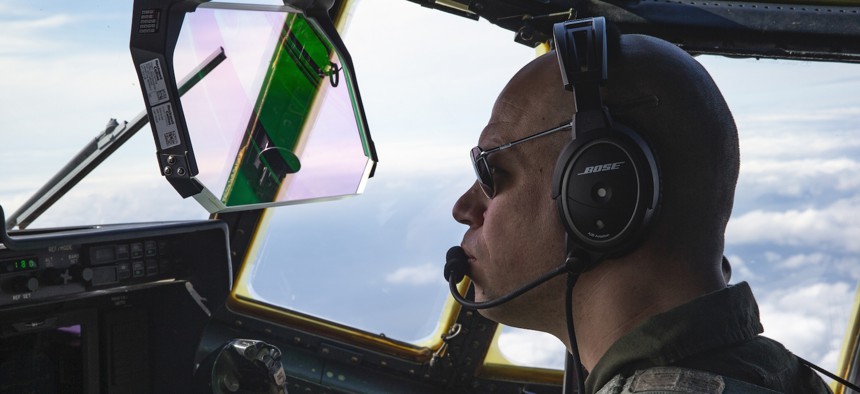
U.S. Marine Corps 1st Lt. Caleb Griffin, a KC-130J Super Hercules pilot with Marine Aerial Refueler Transport Squadron (VMGR) 152 flies a KC-130J off the coast of Japan, Feb. 28, 2019. U.S. Marines with VMGR-152 provide a wide range of capabilities throug U.S. Marine Corps photo by Lance Cpl. Tyler Harmon
Guam Becomes a Living Laboratory for Pentagon’s ‘Connect-Everything’ Experiments
US INDOPACOM and the Air Force are testing new networked warfare solutions in the region right now.
The remote U.S. territory of Guam — crucial to operations in the Pacific, vulnerable to enemy action — is where the Pentagon is testing some of its more ambitious networking concepts.
Officials with U.S. Indo-Pacific Command currently helping the Air Force to demonstrate Advanced Battle Management System, or ABMS, tools, a key part of the U.S. military’s plans for joint-all domain warfare, also called JADC2.
The third so-called ABMS on ramp — a live experiment and demonstration — is taking place in the INDOPACOM area of responsibility from September 15 to 25, an Air Force official confirmed to Defense One on background.
Guam “is a critical nexus for our command and control, for our sustainment, for our logistics and for our power projection” INDOPACOM commander Adm. Phil Davidson said on Thursday.
Davidson has been vocal about wanting to bring an Aegis Ashore anti-missile system to the island as part of a drive, to establish a “360-degree persistent air and missile defense capability on Guam in the near term.”
On Thursday, the admiral argued that the island would be an essential first destination to test and then deploy new JADC2 gear as it evolves. “An integrated capability will extend forward to support maneuvering forces as well from Guam be they Army, Air Force, Navy or Marine. This will help improve the maneuver capability and the fires capability of those terrestrial forces. It’s all within our near-term reach, in my view,” he said.
And it can’t arrive soon enough, in Davidson’s view. He expects Guam to be an early target in a major confrontation. An integrated defense solution would be essential to deny “the adversary the ability to quickly, cheaply and easily knock us out of a fight before it begins,” he said.
During the second ABMS on ramp, which took place at the start of the month, testers used a variety of sensors connected through the Air Force’s cloud to identify a mock cruise missile in time for commanders to take it out with a big, experimental gun. But Davidson said that integrated command and control would also be essential for offensive operations.
The goal is “a system that is ultimately able to match the best interceptor or offensive weapon with the sensed target with the, one day, AI intelligence support that will be working hand in hand with the manpower so that the right authorities are given at the right time to affect that outcome,” he said.
NEXT STORY: Air Force to Try In-Flight Software Update




